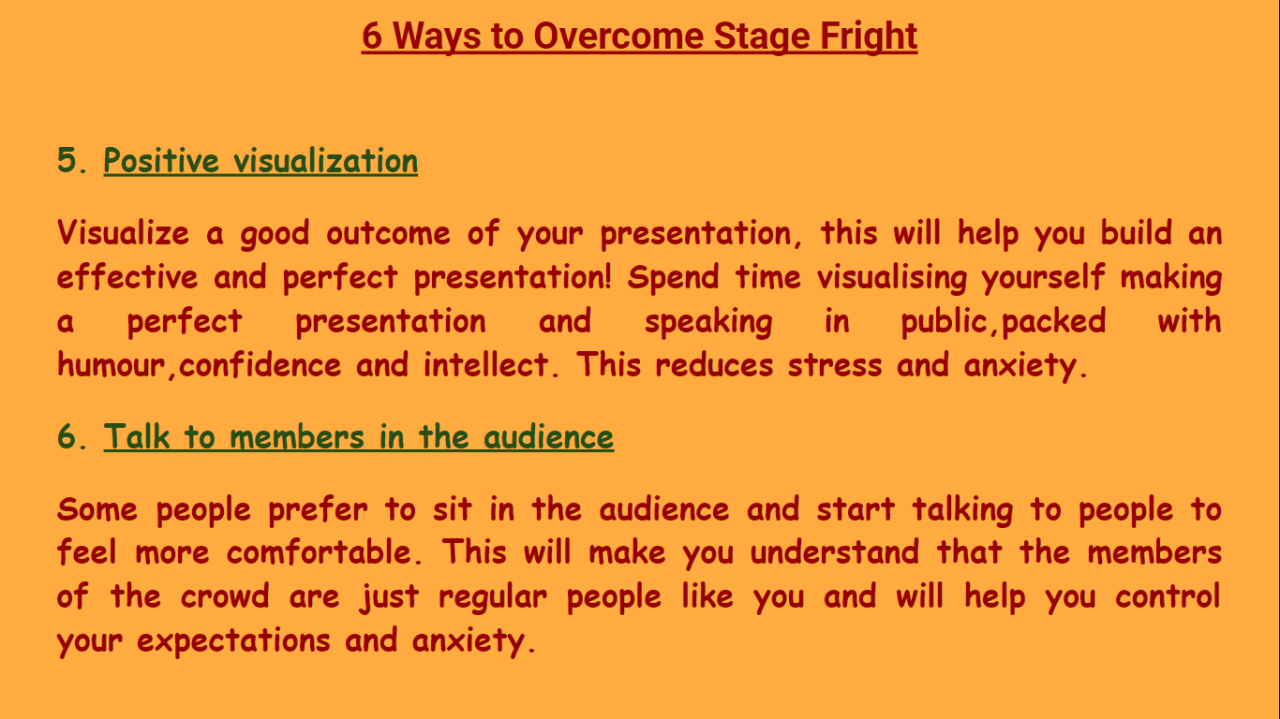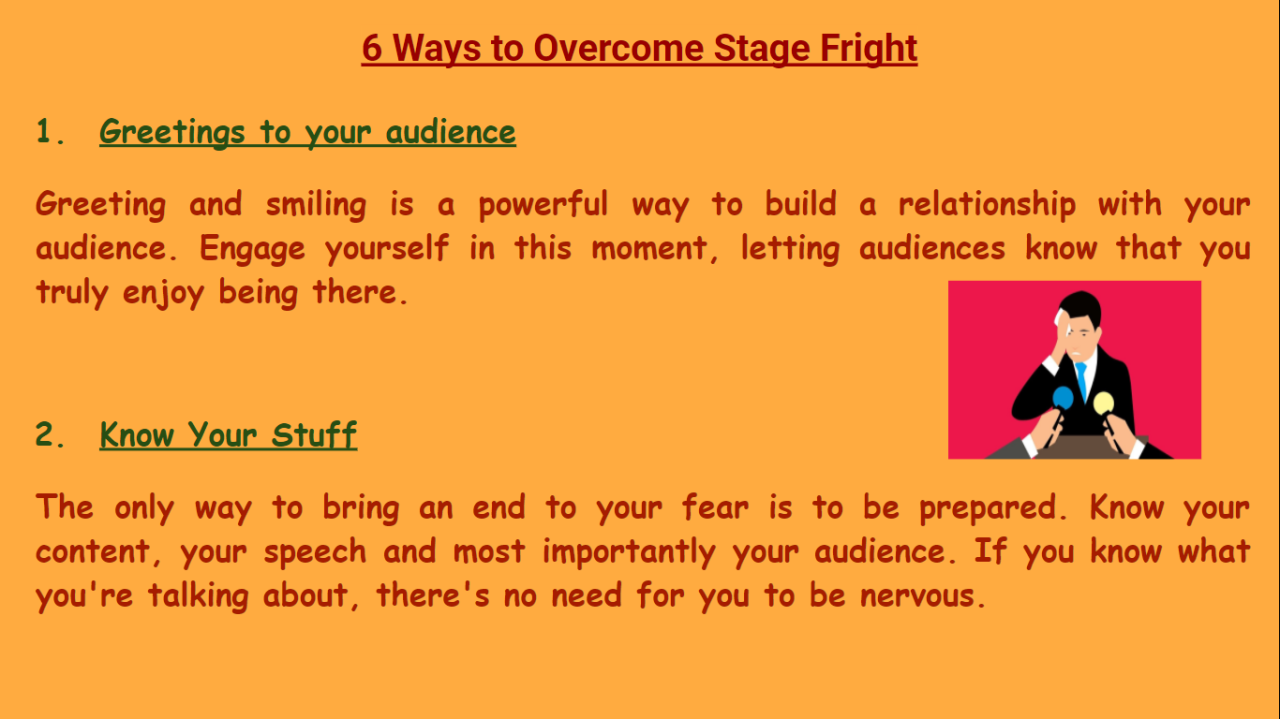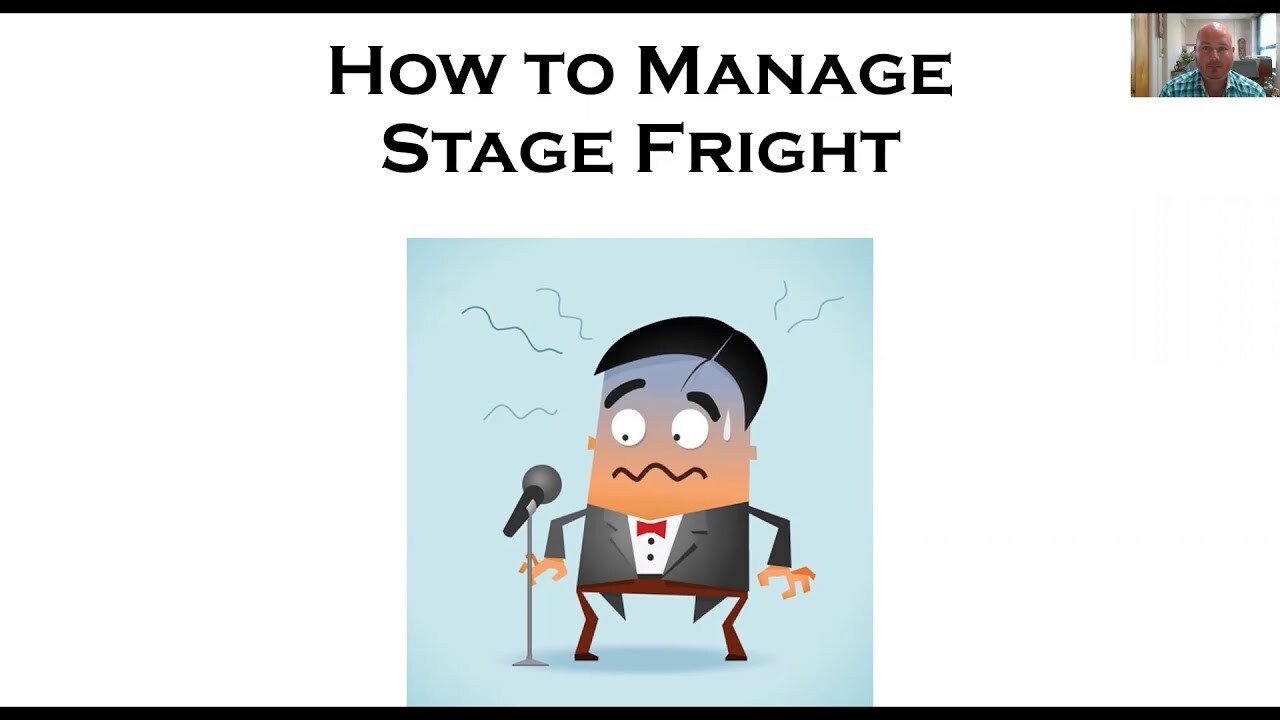Public speaking, a cornerstone of professional and personal growth, can be daunting for many. Stage fright, a common anxiety, can significantly impact performance. This comprehensive guide dives deep into understanding the root causes of stage fright, equipping you with practical strategies to manage and ultimately overcome this fear before your next presentation. We’ll explore a range of effective coping mechanisms, rehearsal techniques, and strategies for building confidence.
From recognizing your personal triggers to developing effective relaxation techniques, this guide provides a roadmap for transforming anxiety into empowerment. We will also explore the critical role of support systems and provide examples to illustrate successful strategies. Whether you’re a seasoned speaker or just beginning, these insights will empower you to approach the stage with confidence and poise.
Understanding Stage Fright

Stage fright, also known as performance anxiety, is a common experience affecting individuals across various situations, from public speaking to performing on stage. It’s characterized by a range of physiological and psychological responses that can significantly impact one’s ability to perform effectively. Understanding the nuances of stage fright is crucial for developing effective coping mechanisms and strategies for managing this anxiety.
Physiological Responses
Stage fright elicits a cascade of physiological responses, often mirroring the body’s “fight or flight” response. These responses are typically amplified in situations where individuals feel vulnerable or exposed. Increased heart rate, rapid breathing, sweating, and trembling are common physical manifestations. These physical sensations can be quite distressing and further contribute to the feeling of anxiety.
Types of Stage Fright
Stage fright can manifest in various forms, each with its own set of characteristics. One type involves a fear of judgment or negative evaluation from the audience. Another form may be rooted in a fear of failure or making mistakes during the performance. There’s also a specific type that stems from a fear of losing control or being unable to deliver the intended performance.
Understanding the specific type of stage fright can help tailor coping strategies.
Psychological Factors
Psychological factors significantly contribute to the development and experience of stage fright. Factors such as past negative experiences, perfectionism, fear of failure, and low self-esteem often play a role. Individuals who have experienced criticism or ridicule in similar situations may develop a heightened sensitivity to potential negative feedback. Additionally, those with a predisposition to anxiety may find that stage fright manifests more readily.
Common Misconceptions
Many misconceptions surround stage fright. One misconception is that it’s solely a sign of lack of confidence or preparation. In reality, it’s a normal human response to stress, affecting even the most skilled and prepared individuals. Another misconception is that stage fright is solely a performance issue, when in fact, it can manifest in various social situations requiring public interaction.
A critical understanding of stage fright moves beyond these common misconceptions.
Comparison with Other Anxiety Disorders
Stage fright shares similarities with other anxiety disorders, particularly social anxiety disorder. While stage fright is typically triggered by performance situations, social anxiety disorder involves a more generalized fear of social interactions. However, the focus and trigger differ; stage fright is performance-specific, whereas social anxiety disorder encompasses a broader range of social situations. It’s important to note the distinction for accurate diagnosis and treatment.
Symptoms of Stage Fright
| Category | Symptoms in Different Individuals |
|---|---|
| Physical | Increased heart rate, rapid breathing, sweating, trembling, nausea, dizziness, dry mouth, muscle tension. |
| Emotional | Nervousness, fear, apprehension, self-consciousness, feelings of inadequacy, panic, and anxiety. |
| Cognitive | Racing thoughts, negative self-talk, difficulty concentrating, memory problems, fear of judgment, and impaired decision-making. |
The table above Artikels the common symptoms of stage fright across various individuals. It’s important to note that the intensity and specific symptoms can vary greatly from person to person.
Recognizing Triggers
Understanding the specific situations and internal factors that trigger stage fright is crucial for developing effective coping mechanisms. Identifying these triggers allows individuals to anticipate and proactively manage their anxiety before it escalates into a debilitating experience. This proactive approach can significantly enhance their ability to perform effectively and confidently.
Common Situations Triggering Stage Fright
A variety of situations can induce stage fright. These can range from the familiar, like public speaking engagements, to the unexpected, like a spontaneous presentation. Common triggers include large audiences, unfamiliar settings, critical evaluation, and a fear of negative judgment. Recognizing these typical triggers can provide valuable insight into the underlying causes of stage fright.
Personal Experiences as Triggers
Personal experiences significantly influence the development of stage fright triggers. Past negative experiences, such as a poorly received presentation or a public embarrassment, can create lasting anxieties. Negative feedback, whether perceived or real, can deeply affect an individual’s self-perception and confidence, making similar situations in the future potent triggers. For instance, a student who experienced a disastrous presentation in front of a large class might develop stage fright triggered by any future presentation, regardless of the audience size.
Similarly, an individual who felt humiliated during a public speech might become anxious in any situation requiring them to speak in front of others.
Importance of Recognizing Individual Triggers
Recognizing individual triggers is paramount for effective stage fright management. While some common triggers exist, the specific situations and experiences that provoke anxiety vary significantly from person to person. Acknowledging these personal triggers allows for a more tailored approach to coping mechanisms. An individual who experiences stage fright triggered by a fear of criticism may benefit from different strategies compared to someone whose trigger is the size of the audience.
Self-Assessment Tool for Identifying Personal Triggers
A self-assessment tool can aid in identifying personal triggers. This tool should incorporate questions regarding past experiences, perceived vulnerabilities, and anxiety-provoking situations. Examples of questions might include: “In what situations have I experienced significant anxiety?” or “What specific aspects of a presentation or performance have caused me to feel anxious?” By reflecting on these questions, individuals can pinpoint their unique triggers and address them more effectively.
The tool should encourage honest self-reflection and provide a structured framework for identifying recurring patterns.
Environmental Factors Contributing to Stage Fright
Environmental factors can significantly impact stage fright. A noisy or unfamiliar venue, a lack of control over the setting, or a poorly lit space can all contribute to increased anxiety. Uncomfortable seating arrangements, unfamiliar technology, or a feeling of being exposed can create a sense of vulnerability and contribute to stage fright. This is particularly true for those who already have underlying anxieties.
Comparison of Common Triggers and Their Impact
| Trigger | Description | Potential Impact on Performance |
|---|---|---|
| Large Audience | Speaking in front of a large group of people. | Increased anxiety, potential for errors in delivery, difficulty connecting with the audience. |
| Unfamiliar Setting | Presenting in a place not frequently visited. | Distraction, disorientation, difficulty focusing on the presentation. |
| Critical Evaluation | Feeling judged or scrutinized by the audience. | Self-consciousness, impaired communication, difficulty maintaining composure. |
| Fear of Negative Judgment | Concern about the audience’s negative reactions. | Hesitation, avoidance of eye contact, reduced engagement with the material. |
Practicing and Rehearsing

Thorough preparation is crucial for conquering stage fright. By actively practicing and rehearsing your speech, you build confidence and reduce the anxiety associated with the unknown. This process allows you to anticipate potential challenges and refine your delivery, ultimately leading to a more polished and engaging presentation. Practicing also strengthens your understanding of the material, making it easier to communicate effectively and confidently.Effective practice involves more than just memorizing words.
It encompasses mastering the nuances of delivery, timing, and vocal projection. Visualization plays a significant role in this process, allowing you to mentally rehearse the experience and build confidence in your ability to perform successfully. Understanding these methods and strategies will empower you to tackle the challenges of public speaking with greater ease and assurance.
Importance of Thorough Preparation
Comprehensive preparation significantly reduces stage fright. A well-structured speech, with a clear understanding of the material, allows you to feel more at ease and confident. The familiarity gained through preparation lessens the fear of the unexpected and promotes a more natural and engaging delivery. This preparation translates into a more fluid presentation, where you can focus on connecting with your audience rather than getting bogged down in anxiety.
Methods for Practicing Speeches in Various Settings
Practicing your speech in different settings mimics the real-world experience, allowing you to adapt to various environments and anticipate potential challenges. Rehearsing in front of a mirror, a friend, or a small group provides valuable feedback and helps identify areas for improvement. For example, practicing in front of a mirror allows you to observe your body language and posture, while practicing in front of a friend offers constructive criticism and an opportunity to refine your communication style.
Consider practicing in quiet spaces to focus on articulation and in more distracting environments to gauge your ability to maintain composure under pressure.
Role of Visualization in Reducing Stage Fright
Visualization techniques are powerful tools for managing stage fright. By mentally rehearsing the speech and the delivery, you can build confidence and reduce anxiety. Imagine yourself delivering the speech successfully, feeling confident and in control. This mental imagery helps to reduce the fear of the unknown and build a positive mental image of the presentation. This can include visualizing the venue, the audience, and yourself delivering the speech smoothly and effectively.
Techniques for Practicing Delivery and Timing
Mastering delivery and timing is essential for a successful presentation. Practice your speech with a stopwatch to ensure you stay within the allotted time. Record yourself to identify areas for improvement in your vocal tone, pace, and body language. Adjust your delivery to match the pacing and tone of the audience, ensuring you maintain eye contact and use appropriate gestures.
Employ techniques like pauses and vocal inflections to emphasize key points and engage your audience effectively. Time yourself while practicing, paying attention to pacing. Adjust your speed if necessary to stay within the allotted time while maintaining clarity.
Rehearsal Strategies for a Speech
A structured approach to rehearsal is beneficial for optimizing performance. Consider these rehearsal strategies:
- Practice in front of a mirror to observe your posture and body language.
- Record yourself to analyze your delivery, tone, and pacing.
- Rehearse in various settings to adapt to different environments.
- Practice with a small group of supportive friends or colleagues to receive feedback and build confidence.
- Use visualization techniques to mentally rehearse the speech and build confidence.
These strategies help you to refine your delivery, manage your anxiety, and ensure a polished and engaging presentation.
Steps Involved in Preparing for a Speech
This table Artikels the essential steps in preparing for a speech, from initial planning to final delivery.
| Stage | Description |
|---|---|
| Planning | Define the topic, research thoroughly, Artikel the structure, and set goals. |
| Drafting | Develop the content, write the introduction, body, and conclusion, ensuring clarity and coherence. |
| Outlining | Organize the content into a clear and logical structure. |
| Rehearsing | Practice delivery, timing, and body language. Use various settings. |
| Finalizing | Review the speech, refine the content, and address any remaining concerns. |
| Delivery | Present the speech with confidence, maintain eye contact, and engage the audience. |
Managing Anxiety During the Speech

Effective management of anxiety is crucial for delivering a successful speech. Understanding your triggers and practicing techniques to stay focused and composed are key components of overcoming stage fright. This section will explore strategies for maintaining focus, handling mistakes, connecting with the audience, and navigating unexpected situations.Anxiety during a speech can be effectively managed by focusing on the present moment.
Techniques for regaining composure during a speech involve a combination of mental and physical strategies, enabling a speaker to stay centered and focused, regardless of external pressures.
Staying Focused During the Speech
Maintaining focus during a speech requires conscious effort. Speakers should actively employ techniques to center themselves and redirect their attention to the material. Deep breathing exercises, mindfulness techniques, and positive self-talk can help regain composure when anxiety arises. Visualization, where a speaker mentally rehearses a successful delivery, can also be beneficial. By concentrating on the message and the audience, the speaker can effectively minimize distractions and maintain a clear and confident demeanor.
Maintaining Composure if Mistakes Happen
Mistakes are inevitable during any speech. Acknowledging this fact and developing strategies for handling them can help mitigate their impact. A speaker should practice forgiveness of oneself, treating errors as learning opportunities rather than catastrophic failures. Maintaining a calm and collected demeanor, even in the face of an unexpected misstep, can help to keep the audience engaged and prevent further anxieties.
Simple verbal corrections, or a subtle shift in the delivery, can often be handled gracefully without disrupting the flow of the speech.
Engaging with the Audience
Effective communication with the audience is vital for a successful speech. Making eye contact, using appropriate body language, and tailoring the delivery to the audience’s needs will build connection. Creating a rapport with the audience through appropriate tone and gestures fosters a sense of engagement and trust. Engaging questions, and even impromptu anecdotes, can enhance the interactive experience and maintain interest.
Handling Unexpected Interruptions or Questions
Unexpected interruptions or questions can be challenging. However, with preparation and a flexible approach, these situations can be navigated effectively. Practicing how to handle a variety of unexpected situations during rehearsals is beneficial. Active listening and a respectful response to interruptions or questions can turn potentially negative situations into opportunities for deeper engagement with the audience. Having a few prepared responses to common questions, or a flexible approach to changing the direction of the speech, will help manage the situation.
Recovering from a Speech with a Challenging Experience
A challenging speech experience, whether due to mistakes, interruptions, or unforeseen circumstances, should be viewed as a learning opportunity. A crucial aspect of recovery is to reflect on the experience without dwelling on negative emotions. Identifying the aspects that contributed to the challenge can help develop coping mechanisms for future presentations. It is important to acknowledge the effort and courage demonstrated in the face of difficulty.
Acknowledging the lessons learned, and focusing on the strengths exhibited during the experience, fosters resilience.
Tips for Handling Unexpected Situations
| Situation | Strategies |
|---|---|
| Unexpected Interruption | Pause, acknowledge the interruption with a calm tone, and then redirect the speech smoothly back to the planned content. |
| Difficult Question | Listen attentively, acknowledge the question, and respond thoughtfully and honestly. If necessary, rephrase the question for clarification, or address it in a concise and focused manner. |
| Technical Issue | Remain calm, address the issue promptly, and if possible, find a solution to resume the speech. If the issue cannot be resolved, acknowledge the situation and continue with the speech. |
| Audience Member’s Disagreement | Listen carefully to the concern. Respond respectfully, and try to address the issue with clarity and reason. Do not get drawn into unproductive arguments. |
Building Confidence

Overcoming stage fright often hinges on building a strong sense of self-assurance. This confidence stems from a variety of internal factors, and developing these will directly impact your ability to handle the pressure of public speaking. A crucial aspect of this process involves understanding the intricate link between self-esteem and the experience of stage fright.A healthy self-esteem acts as a powerful buffer against the anxiety that fuels stage fright.
Individuals with high self-esteem tend to have a more positive outlook on their abilities, leading to greater resilience when faced with challenging situations. Conversely, low self-esteem can amplify feelings of inadequacy and vulnerability, making stage fright more intense and debilitating.
Relationship Between Self-Esteem and Stage Fright
Self-esteem plays a significant role in managing stage fright. A positive self-image fosters a belief in one’s competence and value, which can mitigate the fear of public speaking. Conversely, low self-esteem can intensify feelings of inadequacy, making the prospect of speaking in front of an audience more daunting. This connection underscores the importance of nurturing a healthy sense of self-worth as a crucial step in conquering stage fright.
Importance of Positive Self-Talk
Positive self-talk is a cornerstone of building confidence. Instead of focusing on potential negative outcomes, practicing positive affirmations can help shift one’s mindset. Phrases like “I am prepared,” “I am capable,” or “I can do this” can significantly impact one’s emotional response to the prospect of public speaking. Consistent positive self-talk helps cultivate a more optimistic and resilient attitude, making it easier to handle the anxieties associated with stage fright.
Strategies for Building Self-Confidence
Building self-confidence is a multifaceted process. A range of strategies can be employed to cultivate a strong sense of self-assurance. These include setting realistic goals, celebrating small victories, seeking constructive feedback, and actively pursuing personal growth. Developing these strategies helps to build a sense of mastery and control, which can translate to greater confidence when facing challenges like public speaking.
- Setting Realistic Goals: Break down large tasks into smaller, manageable steps. This fosters a sense of accomplishment with each step, boosting confidence. For instance, if you are preparing for a large presentation, dividing the preparation into smaller sections, like researching, outlining, and practicing, will make the process less daunting.
- Celebrating Small Victories: Acknowledging and celebrating even minor achievements, such as completing a research section or mastering a challenging point in your speech, can reinforce positive feelings and contribute to a growing sense of competence.
- Seeking Constructive Feedback: Actively seeking feedback from trusted sources, such as mentors, colleagues, or friends, can offer valuable insights and help identify areas for improvement. Using this feedback constructively strengthens skills and enhances self-awareness.
- Pursuing Personal Growth: Continuous learning and skill development contribute significantly to building confidence. This could involve taking courses, engaging in relevant activities, or simply seeking out new challenges.
Success Stories of Overcoming Stage Fright
Numerous individuals have successfully overcome stage fright through dedication and strategic approaches. Many public figures, writers, and educators have shared stories of their struggles and triumphs. These narratives demonstrate that overcoming stage fright is attainable through consistent effort and a positive mindset. For example, many successful TED speakers shared stories of overcoming their initial nervousness and using it to motivate them to speak passionately.
Techniques to Boost Self-Esteem and Confidence
| Technique | Description |
|---|---|
| Positive Affirmations | Repeating positive statements about oneself to build self-belief. |
| Visualization | Mentally rehearsing a successful performance to build confidence and reduce anxiety. |
| Journaling | Recording thoughts and feelings about public speaking to gain insights and develop strategies. |
| Seeking Support | Connecting with others who have similar experiences for encouragement and shared strategies. |
| Focusing on Strengths | Identifying and highlighting personal strengths to enhance self-esteem and build confidence. |
Seeking Support
Overcoming stage fright is a journey, and it’s often easier with the support of others. Seeking guidance from mentors, connecting with fellow speakers, and understanding the role of a supportive audience are all crucial components of managing this common fear. Recognizing when professional help is necessary is equally important. This section explores these avenues for support.Seeking support is not a sign of weakness but rather a demonstration of strength and a proactive approach to conquering stage fright.
By surrounding yourself with understanding individuals and utilizing available resources, you empower yourself to build confidence and effectively manage the anxieties associated with public speaking.
Importance of Support from Others
A supportive network can significantly lessen the impact of stage fright. Mentors and advisors, peers, and even a receptive audience can provide encouragement, constructive feedback, and a sense of shared experience. These individuals can offer perspectives and insights that you may not have considered on your own.
Connecting with Mentors or Advisors
Mentors or advisors can offer invaluable guidance and support. They can share their own experiences, provide constructive criticism, and offer strategies for managing anxiety. Seeking out experienced speakers or individuals in leadership roles who can act as mentors can be exceptionally beneficial. Consider attending workshops or conferences, joining professional organizations, or reaching out to individuals who have successfully navigated similar challenges.
These connections can provide a valuable source of inspiration and practical advice.
Support Groups for Public Speakers
Support groups specifically designed for public speakers offer a unique opportunity to connect with others who understand the challenges and triumphs of public speaking. These groups provide a safe space to share experiences, offer encouragement, and receive constructive feedback in a supportive environment. Online forums, local Toastmasters clubs, and workshops for public speaking can be helpful avenues to find such groups.
They offer an opportunity to learn from others’ experiences and to gain a sense of camaraderie among peers.
The Role of a Supportive Audience
A supportive audience can significantly impact a speaker’s performance. A receptive and engaged audience fosters a sense of connection and trust, which can alleviate anxieties and encourage a more confident delivery. Remembering that your audience is there to learn and engage can be a powerful tool for managing stage fright. Positive audience feedback and body language can contribute to a more positive and empowering experience.
Seeking Professional Help
In situations where stage fright significantly interferes with daily life or professional performance, seeking professional help from a therapist or counselor specializing in anxiety management can be beneficial. They can provide personalized strategies for managing anxiety and developing coping mechanisms. Professional help can be a valuable tool in addressing the root causes of stage fright and developing healthier strategies for managing anxiety.
Table of Support Resources
| Resource Type | Description | Example |
|---|---|---|
| Mentors/Advisors | Experienced speakers or leaders who offer guidance and support. | Joining a professional organization, attending workshops, reaching out to successful speakers. |
| Support Groups | Groups specifically designed for public speakers, fostering shared experiences and encouragement. | Toastmasters International, online forums, local public speaking clubs. |
| Supportive Audience | A receptive and engaged audience that fosters connection and trust. | Active listening, positive feedback, engaging body language. |
| Professional Help | Therapy or counseling specializing in anxiety management. | Therapists or counselors experienced in anxiety disorders. |
Illustrative Examples
Understanding the practical application of strategies to overcome stage fright is crucial. Real-life examples provide tangible insights into how individuals have successfully navigated this challenge. These examples showcase the power of preparation, practice, and positive self-talk in transforming fear into confidence.
A Successful Speech
A recent commencement address delivered by a young scientist, Dr. Anya Sharma, exemplified effective stage fright management. She had meticulously researched her topic, practiced her delivery in various settings, and incorporated relaxation techniques into her pre-speech routine. She visualized herself confidently connecting with the audience, and she projected a calm demeanor throughout the speech. Dr.
Sharma’s clear articulation, engaging storytelling, and genuine passion for her subject matter resonated with the audience, leaving a lasting impression. Her speech demonstrated how meticulous preparation and a focus on positive visualization can lead to a successful and impactful presentation.
Negative Impact of Stage Fright
Conversely, a presentation by Mr. David Lee on sustainable agriculture suffered significantly due to stage fright. He had meticulously prepared his slides and Artikeld his arguments, yet his nervousness manifested in a hesitant delivery, a shaky voice, and an inability to maintain eye contact. His speech lacked the flow and dynamism that could have engaged the audience. Had Mr.
Lee incorporated deep breathing exercises, practiced his delivery in front of a mirror or a small group, and utilized positive affirmations, he could have avoided the negative impact of stage fright and presented his ideas more effectively. This highlights the importance of proactive strategies in managing the impact of stage fright.
Coping Mechanisms
Ms. Emily Carter, a seasoned marketing executive, effectively employed several coping mechanisms to manage stage fright during a crucial presentation to potential investors. Recognizing her anxiety, she utilized deep breathing techniques, counting to ten, and focused on the positive outcomes she hoped to achieve. These conscious actions helped her regulate her nervous energy and project confidence, ultimately leading to a successful pitch.
This showcases how mindfulness and strategic coping mechanisms can effectively mitigate the negative effects of stage fright.
Visualization Techniques
Mr. Alex Chen, a renowned motivational speaker, employed visualization techniques to manage his stage fright. He envisioned a positive and successful presentation, picturing himself connecting with the audience, delivering his message with clarity and conviction, and receiving positive feedback. He practiced this visualization routine regularly, strengthening his mental imagery and cultivating a sense of assurance before each presentation.
This demonstrates how powerful visualization can be in fostering confidence and managing anxiety.
Rehearsal Process with Relaxation Techniques
A structured rehearsal process, incorporating relaxation techniques, is crucial. For example, a prospective teacher, Ms. Sarah Kim, incorporated progressive muscle relaxation into her speech rehearsal. She would systematically tense and release different muscle groups, starting with her toes and working her way up to her head. Simultaneously, she practiced her speech in various settings, from a quiet room to a noisy café, gradually increasing the complexity of the environment.
This gradual exposure and relaxation techniques created a more effective and confident delivery. This example highlights the importance of practice in diverse environments coupled with relaxation strategies.
Comparison of Scenarios
| Scenario | Stage Fright Impact | Coping Mechanisms | Outcome |
|---|---|---|---|
| Dr. Anya Sharma’s Commencement Address | Minimal | Thorough preparation, relaxation techniques, positive visualization | Successful and impactful presentation |
| Mr. David Lee’s Sustainable Agriculture Presentation | Significant | Limited | Unsuccessful and disengaging presentation |
| Ms. Emily Carter’s Investor Pitch | Present | Deep breathing, positive affirmations, focused outcomes | Successful pitch |
This table contrasts different scenarios, highlighting the varying impacts of stage fright and the crucial role of coping mechanisms in achieving desired outcomes. Each example underscores the importance of proactive preparation, targeted relaxation, and the power of positive self-talk in mitigating the effects of stage fright.
Last Recap

In conclusion, overcoming stage fright is a journey of self-discovery and skill development. By understanding the physiological and psychological aspects of stage fright, recognizing your personal triggers, and practicing effective coping mechanisms, you can significantly reduce anxiety and enhance your public speaking abilities. Remember that preparation, practice, and positive self-talk are crucial components of this process. With consistent effort and the right strategies, you can confidently navigate any speaking engagement.